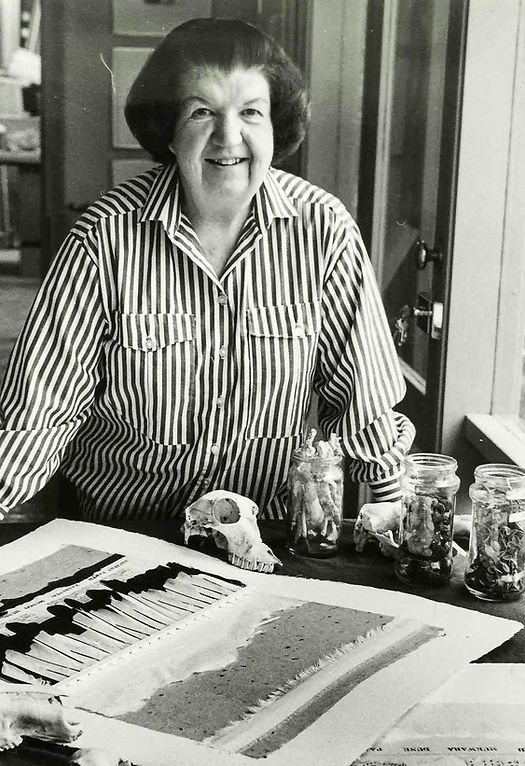Isabel Davies – Artist
ABOUT ISABEL DAVIES

As an artist, Isabel Davies has drawn inspiration from the Women's Art Movement, travel her work as a tour leader and her extensive knowledge of art history.
Born in 1929, artist Isabel Davies completed a Primary and Secondary Drawing Teachers Certificate in 1948. This qualification, initiated by the Education Department in 1908 as a requirement for teaching, emphasised technical skills such as drawing from the cast and perspective, but frustratingly left little room for more adventurous work. Following this study Davies taught art for two years (1949–50) before marrying and beginning a family.
It wasn’t until 1966 that Davies returned to further studies at the National Gallery of Victoria Art School (now Victorian College of the Arts), where she studied under John Brack for two years.
While it wasn’t common at that time for women artists to be taken seriously, Isabel Davies' goal was to become a professional artist, and her first exhibition of paintings was held in 1969.
Davies then sought a new direction and her exhibitions during the early 1970s featured relief constructions made from materials such as aluminium, wood and perspex.

At this time Davies also began documenting her art practice and activities in a series of journals. She collects catalogues, reviews, photographs, articles and other ephemera associated with her work as an artist.

WOMEN'S ART MOVEMENT
Then, in the mid 1970s, influenced by feminism and the women's art movement Isabel Davies' work changed in a number of ways.
She moved away from relief construction, beginning a collage and assemblage practice that has been evident in her work to the present day. At this time, her interest in creating art in boxes also emerged and since then she has used boxes as a vehicle for capturing her ideas.
Artworks created during this period made specific reference to concerns raised by the women's art movement and culminated in a series entitled Masterpieces from the Kitchen.
Significantly, this period also brought new opportunities for collaboration with other women artists:
-
Member of the LIP Collective (1978–82)
-
Founding member and life member of the Women’s Art Register (1979–present)
-
Joint coordinator of the Women’s Art Forum with Erica McGilchrist and Bonita Ely (1978)
-
Team member of ‘Expedition True Desert’ (1988). This was an all-women expedition led by the Australian and New Zealand Scientific Exploration Society working in conjunction with CSIRO on a research project in the Lake Eyre and Lower Simpson Desert areas. The Lake Eyre Series resulted from this collaboration.

-
Member of the 2πr Artists Group (1998–2008). The 2πr Artists Group had 11 members who exhibited together in a series of exhibitions including one at the Monash University Gallery in Prato, Italy. The group showed together over a ten-year period from 1998 until 2008. The collaboration resulted in thematic works including Italian Memory Boxes and Transition at Chillagoe.

TRAVEL
Davies’ inspiration often comes from periods of travel, and she has travelled widely in Australia, Asia and Europe on both group and self-initiated study tours. Particular places have captured her imagination, resulting in multiple survey and research trips to locations including Mungo, Lake Eyre and the Simpson Desert. Her travel includes:
-
Study Tour: Art, Architecture and Archaeology, Europe (1977)
-
Study Tour: Art, Architecture and Archaeology, Indonesia (1981)
-
Lake Mungo Archaeological site, NSW (1982)
-
Around Australia (4 months, 1983)

-
Study Tour: Comparative study of archaeological sites in Egypt, Thailand and Burma (1985)
-
Greece, Italy and other European countries (11 months, 1986)
-
Lake Mungo, NSW (survey and research, 1987)
-
Simpson Desert crossing (survey and research, 1987)
-
Team member of ‘Expedition True Desert’ (led by the Australian and New Zealand Scientific Exploration Society working in conjunction with CSIRO on a research project in the Lake Eyre and Lower Simpson Desert areas) (1988)

-
Kimberley area, WA (survey and research, 1989)
-
Study Tour: Art, Architecture and Archaeology of Spain, Southern Italy and Sicily (1989–90)
-
The Kimberley (survey and research funded by an Australia Council Artist Development Project Grant, 1992)

-
Lake Eyre region (an in-depth look, 1994)
-
Birdsville to the Gulf country (1996)
-
Study Tour: Art and Architecture of Paris and Southern France (1998)
-
Central Australia and surrounding sites (2000)
-
100 days around Australia (survey and research, 2002)
-
Lake Eyre, Muloorina Station and Anna Creek Station (2003)
-
Outback Queensland, including visit to Chillagoe to collect material for proposed series of work (2004)
-
Blacks Beach, QLD (survey and research, 2005)
Extended outback journeys through central Australia and the Kimberley have inspired Davies' practice and resulted in place-specific series of works such as the Mungo Series and the Simpson Desert Series. The sense of travelling through a changing landscape is also evident in Journey and 100 Days around Australia.
The concerns these trips raised have shaped her work: Aboriginal languages and cultures, the impact of European occupation, ecology and the history of each area are recurring themes.

Trips to Italy and Egypt have also sparked a creative response resulting in Italian Memory Boxes and the Egyptian Series.

TOUR LEADER
For eight years from 1990 to 1997 Davies led a five-week tour for Australians Studying Abroad. The tour, Art in the USA, studied contemporary American art, the art of major collections in Los Angeles, Chicago, Washington, Philadelphia and New York. The tour also visited a number of outstanding private collections.

CURRENT PRACTICE
Davies recent works connect her interest in abstraction and collage and feature recurring motifs such as text, numbers, music and found objects. One example is a reflective work she created for the 40th anniversary of the Women's Art Register.



